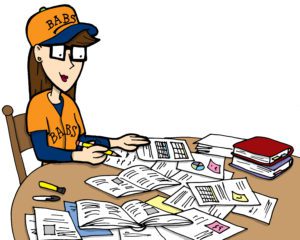Mail! You’ve Got Mail!
 Do you have a question that would be best answered by one of our experts and benefit everyone? Submit it on our Contact Page and put MAILBAG in the Subject Line. We’ll select the best ones to respond to in each of the four Game Plan installments.
Do you have a question that would be best answered by one of our experts and benefit everyone? Submit it on our Contact Page and put MAILBAG in the Subject Line. We’ll select the best ones to respond to in each of the four Game Plan installments.
Ron, love the concept of limiting liabilities. But I wonder if we are penalizing our team too much for risk in the final 10 rounds or so. Those rounds are practically fungible in most leagues, with a lot of churning. It seems like my team makeup shouldn’t be “penalized” as much for having more risk in those final rounds. I don’t want a big liability player in the first 4 or 5 rounds, but I’m fine with that risk in the final 4 or 5 rounds. Maybe we should adjust our liability budget to a higher number, then assess triple points for the first third of the draft, double points for the middle third, and just one point for the bottom third? (Just thinking out loud on that being the adjustment.)
That’s an interesting perspective. Although I am loathe to add more complexity to the system, your idea makes some sense. It is too late to implement anything formal for this year, but let’s all think about this. If folks would like to weigh in on this idea in the forums, I’d love to hear from you.
As it turns out, I ended up facing this same situation in the LABR 12-team Mixed experts league that drafted this past weekend. The core of my team was all high-priced players with no injury risk – Bellinger, Story, JD Martinez, Starling Marte and Jack Flaherty. It was only in the end-game that I started taking on the players with injury history – guys like Peralta, Dickerson and Daniel Murphy. In this shallower league, the free agent pool is teeming with talent, so even these full-timers could be fungible. So you’re right – I’m less concerned about these lesser players.
I don’t know how a player adds or loses skills over the past two weeks with no intervening injuries. For example, how does a pitcher like Lance Lynn go from e to ER in that interval or Jacob DeGrom go from K+ to KK or Robbie Ray grow an e? None of their stats have changed, but something has.
Players like this are usually on the cusp between two ratings. Nothing has changed with their skill, but the place where they reside in the skills range might change slightly with each update.
Using an example from “The BABS Project 3.0: “(I)f the range of reasonably expected performance for batting average is .200 to .320, the top 10 percent of that range would be .308 to .320. Any number of players could merit inclusion in that range.”
However, if the composition of the player pool shifts that range, even slightly, say, to .210 to .325, then the cut-off for each BABS rating would move slightly as well.
FWIW, in the case of Ray, if he was projected for even 1/3 inning less, he would not have merited the (e) rating. That’s how close to the cusp he is.
Curious: what is historical record for how sophomore players at top of assessment, like Tatis, have performed that year?
I don’t think we can make generalizations. How each sophomore performs depends on how able he is to adjust to the competition. Tatis’ position atop the grid is unique, but overdrafted sophomores are high risk picks historically. I keep going back to the example of Carlos Correa who came into his sophomore campaign with an ADP of 6, and has never finished in the Top 50 in any year since. But it’s easy to cherry-pick.
Not a perfect comp, but I wrote an article for The Athletic last year that looked at highly rated rookies who flopped and how they could hold hidden value as sophomores. The examples I gave were Ryan McMahon, Scott Kingery, Dustin Fowler, Willie Calhoun, J.P. Crawford and Lewis Brinson. It was a mixed bag; the first two improved, the other four continued to struggle.
